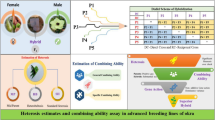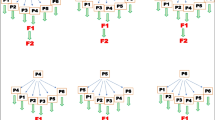Abstract
There has been a strong demand for oat genotypes that contain caryopsis with high chemical quality which can suit the different market niches. Therefore, the objectives of this study were to assess the general (GCA) and specific combining ability (SCA) of white oat cultivars through diallelic crosses providing information about the genetic effects on expression of grain chemical quality components. Also, it was aimed to estimate the heterosis on F1 and F2 generations and the vigor loss due to inbreeding. During 2008, 21 hybrid populations F1 and F2 were obtained from artificial crossing among seven Brazilian white oat cultivars, following the complete diallel design, without considering the reciprocals. These populations and their parents were evaluated in the 2009 season in the experimental field in Capão do Leão, RS, Brazil. The higher values of mean squares associated to GCA indicates a strong contribution of additive genetic effects to the expression of grain chemical components. The parents tested showed a tendency to develop progeny with negative heterosis regarding protein, lipid, β-glucan and soluble dietary fiber in the grain, and positive for the content of nitrogen-free extract, total and insoluble dietary fiber. IAC 7 features a potential parent for obtaining grains with high protein and dietary fiber content, and low caloric content, fit to human diet. Meanwhile, UPF 15 and FAPA Louise can represent donors of alleles to increase lipid contents, while FAPA Louise and URS Guapa can be used to raise the grain nitrogen-free extract contents of lines intended for animal feeding.


Similar content being viewed by others
Abbreviations
- Prot:
-
Protein content
- Lip:
-
Lipid
- β-glu:
-
Β-glucan
- NFE:
-
Nitrogen-free extract
- TDF:
-
Total dietary fiber
- IDF:
-
Insoluble dietary fiber
- SDF:
-
Soluble dietary fiber
- SCA:
-
Specific combining ability
- GCA:
-
General combining ability
- H1 :
-
Heterosis
- Id:
-
Inbreeding depression
- LV:
-
Loss of vigor
References
AACC (American Association of Cereal Chemists) (1999) Approved methods, 9th edn. American Association of Cereal Chemists, Saint Paul
Ahokas H, Manninen ML (2000) Introgressive hexaploid oats from the Avena abyssinica (♀) × A. sativa hybrid: performance, grain lipids and proteins. Euphytica 111:153–160. doi:10.1023/A:1003850015682
Allard RW (1999) Principles of plant breeding, 2nd edn. Wiley, New York
Aman P, Graham H (1987) Analysis of total and insoluble mixed-linked (1 → 3), (1 → 4)-β-d-glucans in barley and oats. J Inst Food Chem 35:706–709. doi:10.1021/jf00077a016
Anderson JW, Bridges SR (1993) Hipocholesterolemic effects of oat bran in humans. In: Wood PJ (ed) Oat bran. American Association of Cereal Chemists, St. Paul, pp 139–157
Andon MB, Anderson JWA (2008) The oatmeal-cholesterol connection: 10 year later. AJLM 2:55–57. doi:10.1177/1559827607309130
ANVISA—National Agency for Sanitary Surveillance (1999) Advisory technoscientific committees in functional foods and novel food. http://www.anvisa.gov.br/alimentos/comissoes/tecno_bk.htm#RESOLUÇÕES ANVS/MS. Accessed 1 Apr 2011
AOAC (Association of Official Analytical Chemistry) (1997) Official methods of analysis of the Association of Official Analytical Chemistry, 16th edn. AOAC, Washington
Baker RJ, McKenzie RIH (1972) Heritability of oil content in oats. Crop Sci 12:201–202. doi:10.2135/cropsci1972.0011183X001200020015x
Barbosa Neto JF, Matiello RR, Carvalho FIF, Oliveira JMS, Pegoraro DG, Schneider F, Sordi MEB, Vacaro E (2000) Genetic progress in oat breeding in southern Brazil. Pesq Agropec Bras 35:1605–1612. doi:10.1590/S0100-204X2000000800013
Beber RC, Francisco A, Alves AC, De Sá RM, Ogliari P (2002) Chemical characterization of Brazilian oat genotypes. Acta Científica Venezolana 53:202–209
Bell S, Goldman VM, Bistrian BR, Arnold AH, Ostroff G, Forse RA (1999) Effect of β-glucan from oats and yeast on serum lipids. Crit Rev Food Sci Nutr 39:189–202
Bennetzen JL, Freeling M (1997) The unified grass genome: synergy in synteny. Genome Res 7:301–306. doi:10.1101/gr.7.4.301
Bertan I, Carvalho FIF, de Costa Oliveira A, Silva JAG, Benin G, Hartwig I, Schmidt DAM, Valério IP, Fonseca DR, Silveira G (2009) Effects of heterosis and endogamy on agronomic important traits in wheat. Rev Ceres 56:753–763
Brazilian Oat Research Committee (2006) Technical indications for oat. Fundação Agrária de Pesquisa Agropecuária, Guarapuava
Brown CM, Aryeetey AN, Dubey SN (1973) Inheritance and combining ability for oil content in oats (Avena sativa L.). Crop Sci 14:67–69. doi:10.2135/cropsci1974.0011183X001400010020x
Butt MS, Tahir-Nadeem M, Khan MKI, Shabir R, Butt MSA (2008) Oat: unique among the cereals. Eur J Nutr 47:68–79. doi:10.1007/s00394-008-0698-7
Carvalho FIF, Lorenceti C, Marchioro VS, Silva SA (2008) Conduction of populations in plant breeding, 2nd edn. UFPEL, Pelotas
Cervantes-Martinez CT, Frey KJ, White PJ, Wesenberg DM, Holland JB (2001) Selection for greater β-glucan content in oat grain. Crop Sci 41:1085–1091. doi:10.2135/cropsci2001.4141085x
Chawade A, Sikora P, Bräutigam M, Larsson M, Vivekanand V, Nakash MA, Chen T, Olsson O (2010) Development and characterization of an oat TILLING-population and identification of mutations in lignin and β-glucan biosynthesis genes. BMC Plant Biol 10:1–13. doi:10.1186/1471-2229-10-86
Chernyshova AA, White PJ, Scott MP, Jannink JL (2007) Selection for nutritional function and agronomic performance in oat. Crop Sci 47:2230–2239. doi:10.2135/cropsci2006.12.0759
Crestani M, Silveira SFS, Mezzalira I, Tessmann E, Ribeiro G, Silva JAG, Gutkoski LC, Carvalho FIF, de Costa Oliveira A (2009) Relation among the grain yield components, industrial yield components and grain chemical quality in white oat. In: Brazilian Oat Research Committee (ed) Experimental results of the XXIX Brazilian Oat Research Committee Meeting. UFRGS, Porto Alegre, pp 28–31
Crestani M, Carvalho FIF, de Costa Oliveira A, Silva JAG, Gutkoski LC, Sartori JF, Barbieri RL, Baretta D (2010) β-glucan content in white oat cultivars grown in different environments. Pesq Agropec Bras 45:261–268. doi:10.1590/S0100-204X2010000300005
Cruz CD (2001) Genes program—version Windows 2001.0.0. UFV, Viçosa
Cruz CD, Vencovsky R (1989) Comparison of some methods of diallel analysis. Braz J Genet 12:425–438
Cruz CD, Regazzi AJ, Carneiro PCS (2004) Biometric models applied to genetic improvement, 3rd edn. UFV, Viçosa
De Sá RM, Francisco A, Soares FCT (1998) Oat (Avena sativa L.) β-glucan concentration in different processing stages. Ciênc Tecnol Aliment 18:425–427. doi:10.1590/S0101-20611998000400013
De Sá RM, Francisco A, Ogliari PJ, Bertoldi FC (2000) Beta-glucan content variation in Brasilian oat cultivars. Ciênc Tecnol Aliment 20:99–102. doi:10.1590/S0101-20612000000100019
Doehlert DC, McMullen MS, Hammond JJ (2001) Genotypic and environmental effects on grain yield and quality of oat grown in North Dakota. Crop Sci 41:1066–1072. doi:10.2135/cropsci2001.4141066x
Falconer DS, Mackay TFC (1996) Introduction to quantitative genetics, 4th edn. Longmans Green, Harlow
FDA Food Labeling (1997) Health claims: oats and coronary disease. Fed Reg 62:3583–3601
Federizzi LC, Milach SCK, Pacheco MT, Barbosa Neto JF, Sereno MJCM (2005) Melhoramento da aveia. In: Borém A (ed) Improvement of cultivated species, 2nd edn. UFV, Viçosa, pp 141–169
Floss EL, Silveira AAE, Veras AL, Augustin L, Doro C, Schulz J, Veloso CB, Gutkoski LC (1998) Production and processing of oat. In: Fioreze I (ed) Polo scientific and technological development—nucleus of food. EDIUPF, Passo Fundo, pp 55–88
Frey KJ, Holland JB (1999) Nine cycles of recurrent selection for increased groat-oil content in oat. Crop Sci 39:1636–1641. doi:10.2135/cropsci1999.3961636x
Griffing B (1956) Concept of general and specific combining ability in relation to diallel crossing systems. Aust J Biol Sci 9:463–493
Gullord M (1980) Oil and protein content and ists relation to other characters in oats (Avena sp.). Acta Agric Scand 30:216–218. doi:10.1080/00015128009435269
Gutkoski LC, Trombetta C (1999) Evaluation of dietary fiber and beta-glucan levels in oat (avena sativa L.) cultivars. Ciênc Tecnol Aliment 19. http://www.scielo.br/scielo.php?script=sci_arttext&pid=S0101-20611999000300016. Accessed 16 Aug 2011. doi: 10.1590/S0101-20611999000300015
Holland JB (1997) Oat improvement. In: Kang MS (ed) Crop improvement for the 21st century. Research Signpost, Trivandrum, pp 57–98
Holthaus JF, Holland JB, White PJ, Frey KJ (1996) Inheritance of β-glucan content of oat grain. Crop Sci 36:567–572. doi:10.2135/cropsci1996.0011183X003600030006x
Humphreys DG, Mather DE (1996) Heritability of β-glucan, groat percentage and crown rust resistance in two oat crosses. Euphytica 91:359–364. doi:10.1007/BF00033098
ISI (Infrasoft International of NIRSystems) (1996) Routine operation and calibration development manual—version 4.0. Perstorp Analytical Company, Maryland
Karow RS, Forsberg RA (1984) Oil composition in parental, F1, and F2 populations of two oat crosses1. Crop Sci 24:629–632. doi:10.2135/cropsci1984.0011183X002400040001x
Kianian SF, Egli MA, Phillips RL, Rines HW, Somers DA, Gengenbach BG, Webster FH, Livingston SM, Groh S, O’Donoughue LS, Sorrell ME, Wesenberg DM, Stuthman DD, Fulcher RG (1999) Association of a major groat oil content QTL and an acetyl-CoA carboxylase gene in oat. Theor Appl Genet 98:884–894. doi:10.1007/s001220051147
Kianian SF, Phillips RL, Rines HW, Fulcher RG, Webster FH, Stuthman DD (2000) Quantitative trait loci influencing β-glucan content in oat (Avena sativa, 2n = 6x = 42). Theor Appl Genet 101:1039–1048. doi:10.1007/s001220051578
Lim HS, White PJ, Frey KJ (1992) Genotypic effects on β-glucan content of oat lines grown in two consecutive years. Cereal Chem 69:262–265
Lorencetti C, Carvalho FIF, Benin G, Marchioro VS, Oliveira AC, Silva JAG, Hartwig I, Schmidt DAM, Valério IP (2005) Combining ability and heterosis in diallelic oat crosses. Rev Bras Agrociência 11:143–148
Loskutov IG (2000) Some quality groat characters in oat wild species. In: Cross RJ (ed) Proceedings of the sixth international oat conference, New Zealand, pp 248–253
Manthey FA, Hareland GA, Huseby DJ (1999) Soluble and insoluble dietary fiber content and composition in oat. Cereal Chem 76:417–420. doi:10.1094/CCHEM.1999.76.3.417
Mather K, Jinks JL (1982) Biometrical genetics. Chapman and Hall, London
McDonald A, Shinnick F, Ink S (1992) Review of the effects of oats on human health. In: Barr AR (ed) The changing role of oats in human and animal nutrition. Proceedings of the Fourth International Oat Conference. Robee Bureau Services, Adelaide, pp 1–8
Orr W, Molnar SJ (2007) Development and mapping of PCR-based SCAR and CAPS markers linked to oil QTLs in oat. Crop Sci 47:848–852. doi:10.2135/cropsci2006.01.0053
Pedó I, Sgarbieri VC, Gutkoski LC (1999) Protein evaluation of four aot (Avena sativa L.) cultivars adapted for cultivation in the south of Brazil. Plant Foods Hum Nutr 53:297–304. doi:10.1023/A:1008032013635
Peterson DM, Wesenberg DM, Burrup DE, Erickson CA (2005) Relationships among agronomic traits and grain composition in oat genotypes grown in different environments. Crop Sci 45:1249–1255. doi:10.2135/cropsci2004.0063
Price PB, Parsons JG (1975) Lipids of seven cereal grains. J Am Oil Chem Soc 52:490–493. doi:10.1007/BF02640738
Ramalho MAP, Santos JB, Zimmermann MJO (1993) Quantitative genetics in autogamous plants. UFG, Goiânia
Santos HG, Jacomine PKT, Anjos LHC, Oliveira VA, Oliveira JB, Coelho MR, Lumbreras JF, Cunha TJF (2006) Brazilian system of soil classification. Embrapa Solos, Rio de Janeiro
Silva CFL, Milach SCK, Silva SDA, Federizzi LC, Montero CR, Fontaneli RS (2006) Oat fiber fractions and their application in breeding programs. Pesq Agropec Bras 41:975–980. doi:10.1590/S0100-204X2006000600011
Silva CFL, Milach SCK, Silva SDA, Montero CR (2008) Near infrared reflectance spectroscopy (NIRS) to assess protein and lipid contents in Avena sativa L. Crop Breed Appl Biotechnol 8:127–133
Thro AM, Frey KJ (1985) Inheritance of groat-oil content and high-oil selection in oats (Avena sativa L.). Euphytica 34:251–263. doi:10.1007/BF00022917
Wood PJ (1993) Physicochemical characteristics and physiological properties of oat (1–3), (1–4)-β-d-Glucan. In: Wood PJ (ed) Oat bran. American Association of Cereal Chemists, St. Paul, pp 83–112
Zhou M, Robards K, Glennie-Holmes M, Helliwell S (1999) Oat lipids. J Am Oil Chem Soc 76:159–169. doi:10.1007/s11746-999-0213-1
Zhu S, Rossnagel BG, Kaeppler HF (2004) Genetic analysis of quantitative trait loci for groat protein and oil content in oat. Crop Sci 44:254–260. doi:10.2135/cropsci2004.2540
Acknowledgments
The authors are thankful to the Brazilian Council for Research and Development (CNPq), Higher Education Improvement Bureau (CAPES) and Rio Grande do Sul State Research Assistance Foundation (FAPERGS) for grants and fellowship support.
Author information
Authors and Affiliations
Corresponding author
Additional information
This article is the part of the Doctor of Science thesis of Crestani Maraisa.
Rights and permissions
About this article
Cite this article
Crestani, M., Silveira, S.F.S., Tessmann, E.W. et al. Combining ability for grain chemistry quality traits in a white oat diallelic cross. Euphytica 185, 139–156 (2012). https://doi.org/10.1007/s10681-012-0641-0
Received:
Accepted:
Published:
Issue Date:
DOI: https://doi.org/10.1007/s10681-012-0641-0




